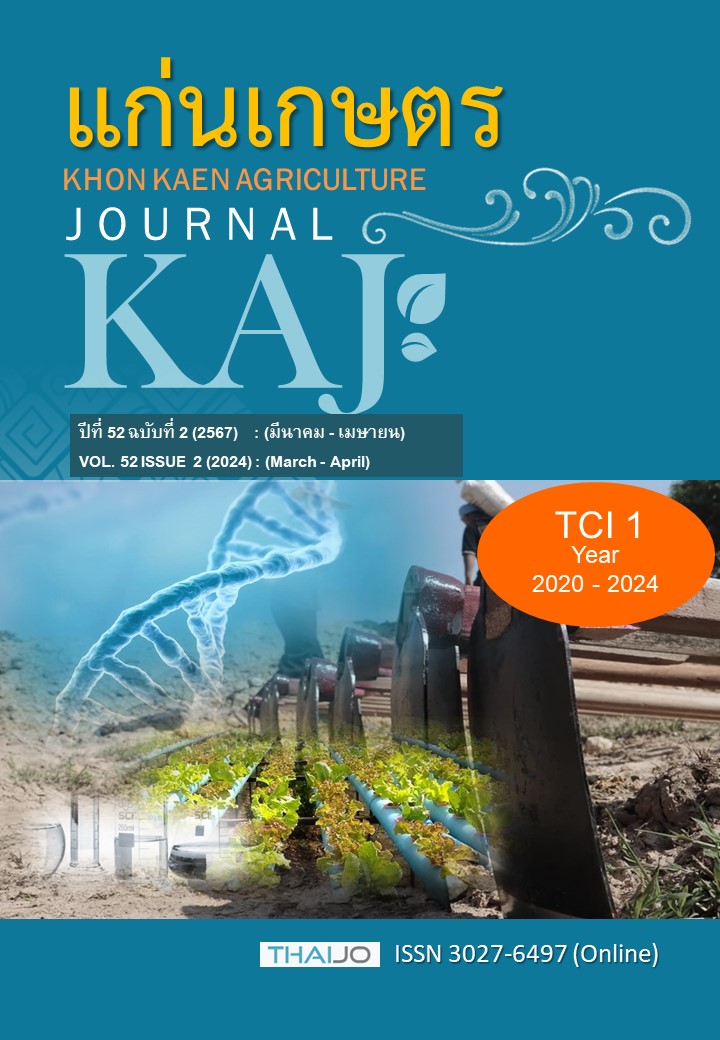การเพาะเลี้ยงมดแดงในครัวเรือน กรณีศึกษาพื้นที่แปลงปลูกไม้มีค่าทางเศรษฐกิจในจังหวัดสุรินทร์
Main Article Content
บทคัดย่อ
งานวิจัยนี้มีวัตถุประสงค์เพื่อศึกษาชนิดพันธุ์ไม้ ปริมาณผลผลิต ต้นทุน และรายได้จากการเลี้ยงมดแดงในพื้นที่แปลงปลูกไม้มีค่าทางเศรษฐกิจของกลุ่มวิสาหกิจชุมชนรักษ์ป่าพัฒนาชีวิตด้วยเศรษฐกิจพอเพียง จังหวัดสุรินทร์ ทำการคัดเลือกแปลงปลูกโดยการสุ่มตัวอย่างแบบเจาะจงจำนวนทั้งหมด 7 แปลง ผลการศึกษา พบว่าพันธุ์ไม้ที่มดแดงมักใช้สร้างรังมีจำนวนทั้งสิ้น 16 ชนิด ประกอบด้วยไม้ยืนต้น ไม้เลื้อยเนื้อแข็ง และไม้พุ่มเตี้ย และพบว่ามะม่วงเป็นพันธุ์ไม้ที่มดแดงเลือกใช้ในการสร้างรังมากที่สุด คิดเป็นร้อยละ 17.42 รองลงมาเป็นต้นยางนา มะฮอกกานี หว้า แดง และสะเดา คิดเป็นร้อยละ 14.39, 10.61, 9.09, 8.33 และ 8.33 ตามลำดับ พบการสร้างรังมดแดงตั้งแต่ 1 รัง/ต้น ถึง 12 รัง/ต้น ขนาดของรังมดแดงมีตั้งแต่ 9.4 x 12.2 เซนติเมตร ซึ่งพบบนต้นน้ำใจใคร่ ถึงขนาด 24.8 x 31.5 เซนติเมตร บนต้นกระถินเทพา หลังจากเลี้ยงมดแดงเป็นระยะเวลา 6 เดือน ได้ปริมาณผลผลิตตั้งแต่ 18.5 - 285.5 กรัม/รัง เมื่อวิเคราะห์ต้นทุนทางเศรษฐศาสตร์เป็นระยะเวลา 6 เดือน (กันยายน 2565 - กุมภาพันธ์ 2566) พบว่าต้นทุนทั้งหมดเฉลี่ยเท่ากับ 4,576.77 บาทต่อแปลงต่อรอบการเลี้ยง เกษตรกรเก็บผลผลิตมดแดงตั้งแต่ช่วงต้นเดือนกุมภาพันธ์ถึงปลายเดือนพฤษภาคม ปริมาณผลผลิตเท่ากับ 5.0 - 10.0 กิโลกรัม รายได้เท่ากับ 3,500 - 7,000 บาทต่อแปลงต่อรอบการเลี้ยง ราคาจำหน่ายกิโลกรัมละ 700 บาท
Article Details

อนุญาตภายใต้เงื่อนไข Creative Commons Attribution-NonCommercial-NoDerivatives 4.0 International License.
เอกสารอ้างอิง
ขวัญตา ตันติกำธน, ประสิทธิ์ ศรีนคร และเตือนใจ ปิยัง. 2561. วงจรชีวิต การเลือกแหล่งสร้างรัง และกำลังผลิตมดแดง (Oecophylla smaragdina Fabricius, 1775) ในป่าเสม็ดมหาวิทยาลัยเทคโนโลยีราชมงคลศรีวิชัย จังหวัดตรัง. รายงานวิจัย. คณะวิทยาศาสตร์และเทคโนโลยีการประมง มหาวิทยาลัยเทคโนโลยีราชมงคลศรีวิชัย.
ทิพากร ภูสาคร, เดชา วิวัฒน์วิทยา และวัฒนชัย ตาเสน. 2562. ชนิดอาหารเทียมที่เหมาะสมเพื่อการเพาะเลี้ยงมดแดง. วารสารวนศาสตร์. 38(1): 13-23.
ปริญญา เพชรประพันธ์ และวียะวัฒน์ ใจตรง. 2551. การเพาะเลี้ยงมดแดงเพื่อการค้า. วารสารการจัดการป่าไม้. 2(3): 93–102.
ไพศาล ศุภางคเสน. 2542. มดและพืชเพื่อนผู้มีประโยชน์. วารสารกีฏและสัตววิทยา. 21: 210-212.
รัตนวดี ชารีวาร และเดชา วิวัฒน์วิทยา. 2559. ตำแหน่งรังราชินีมดแดงในประเทศไทย. วารสารวนศาสตร์. 35(1): 1-10.
รุ่งทิวา ว่องวิกย์การ และไพฑูรย์ เล็กสวัสดิ. 2531. รัง ประชากรและการเจริญเติบโตของมดแดง Oecophylla smaragdina F. น. 373-383. ใน: รายงานการประชุมทางวิชาการของมหาวิทยาลัยเกษตรศาสตร์ ครั้งที่ 26. มหาวิทยาลัยเกษตรศาสตร์ บางเขน กรุงเทพฯ.
วิษณุรักษ์ ศรีบัณฑิต. 2550. นิเวศวิทยาบางประการและการตลาดของมดแดง. วิทยานิพนธ์ ปริญญาวิทยาศาสตรมหาบัณฑิต มหาวิทยาลัยเกษตรศาสตร์.
องุ่น ลิ่ววานิช, ยงยุทธ ไวคกุล, อาจินต์ รัตนพันธุ์ และยุพา หาญบุญทรง. 2544. การสำรวจแมลงกินได้ในภาคตะวันออกเฉียงเหนือ. แก่นเกษตร. 29(1): 35-44.
Abdalbasit, A.M., E.S.M. Mohamed, and H. Ismail. 2017. Chapter 45: Oecophylla smaragdina Fabricius Weaver Ant. Unconventional Oilseeds and Oil Sources. Academic Press. 299-304.
Atanu, M., C. Angsuman, and K.R. Srimanta. 2020. On the use of red ant Oecophylla smaragdina by the indigenous people of Binpur, Jhargram, West Bengal. International Research Journal of Basic and Applied Sciences. 5: 67-71.
Barzman, M.S., N.J. Mills, and N.T.T. Cuc. 1996. Traditional knowledge and rationale for weaver ant husbandry in the Mekong Delta of Vietnam. Agriculture and Human Values. 13: 2–9.
Chen, P.P., S. Wongsiri, T. Jamyanya, T.E. Rinderer, S. Vongsamanode, M. Matsuka, H.A. Sylvester, and B.P. Oldroyd. 1998. Honey bees and other edible insects used as human food in Thailand. American Entomologist. 44(1): 24-29.
DeFoliart, G.R. 1999. Insects as food: why the western attitude is important. Annual Review of Entomology. 44: 21-50.
Holldobler, B.K., and E.O. Wilson. 1990. The ant. Cambridge: Harvard University Press.
Kazuki, T., H. Ahsol, N. Harlion, and N. Koji. 2004. Asian weaver ants, Oecophylla smaragdina, and their repelling of pollinators. Ecological Research. 19: 669-673.
Offenberg, J., and D. Wiwatwitaya. 2009. Weaver ants convert pest insects into food-prospects for the rural poor. Proceedings of Tropentag 2009 conference. In: International Research on Food Security, Natural Resource Management and Rural Development. Hamburg. http://www.tropentag.de/2009/abstracts/full/309.pdf.
Offenberg, J., and D. Wiwatwitaya. 2010. Sustainable weaver ant (Oecophylla smaragdina) farming: harvest yields and effects on worker ant density. Asian Myrmecology. 3: 55-62.
Offenberg, J., N.T.T. Cuc, and D. Wiwatwitaya. 2013. The effectiveness of weaver ant (Oecophylla smaragdina) biocontrol in Southeast Asian citrus and mango. Asian Myrmecology. 5: 139-149.
Peng, R.K., and K. Christian. 2006. Effective control of Jarvis's fruit fly, Bactrocera jarvisi (Diptera :Tephritidae), by the weaver ant, Oecophylla smaragdina (Hymenoptera : Formicidae), in mango orchards in the Northern Territory of Australia. International Journal of Pest Management. 52: 275-282.
Sribandit, W., D. Wiwatwittaya, S. Suksard, and J. Offenberg. 2008. The importance of weaver ant (Oecophylla smaragdina Fabricius) harvest to a local community in Northeastern Thailand. Asian Myrmecology. 2: 129-138.
Van Mele, P., and N.T.T. Cuc. 2000. Evolution and status of Oecophylla smaragdina as a pest control agent in citrus in the Mekong Delta, Vietnam. International Journal of Pest Management. 46: 295-301.
Van Mele, P. 2008. A historical review of research on the weaver ant Oecophylla in biological control. Agricultural and Forest Entomology. 10: 13-22.
Van Mele, P., and N.T.T. Cuc. 2007. Ants as friends: Improving your tree crop with weaver ants. 2nd Edition. Africa Rice Center (WARDA), Ants as Friends. Cotonou, Benin and CABI. Egham, UK.
Wiwatwitaya, D. 2009. Weaver ant life. Forest Biology Department, Faculty of Forestry, Kasetsart University. Bangkok.


